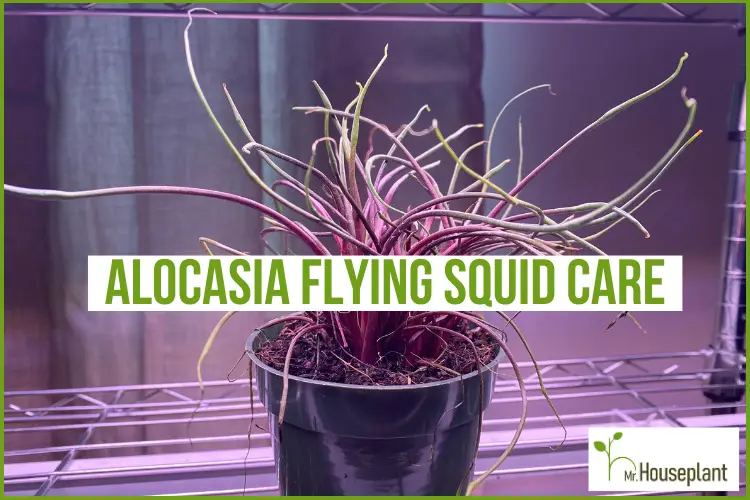
Are you excited to acquire Alocasia Flying Squid, but also worried whether you’ll be up to the task? This detailed guide will alleviate all your concerns. Read on to learn everything about watering, light requirements, fertilizing, repotting, and other necessary care steps to grow a healthy and beautiful Flying Squid plant.
| Botanical Name (Latin Name/Scientific Name): | Alocasia Plumbae |
| Common Name: | Alocasia Flying Squid |
| Light: | bright light (3,000+ lux; 300+ foot candles) |
| Watering: | once the top half of the soil is dry |
| Soil: | well-draining potting mix |
| Repotting: | once a year |
| Fertilizing: | every 2 to 4 weeks with a high nitrogen fertilizer |
| Temperature: | Between 65°F and 75°F (18°C and 24°C) |
| Humidity: | ideally over 50%, but it might adapt to lower humidity |
| Toxicity for Pets: | Toxic (oral irritation, pain and swelling of mouth |
| Toxicity for Humans: | oxic (skin irritation, rash, throat swelling) |
| Pruning: | prune dead or diseased growth |
Alocasia Flying Squid is a fun plant from the Alocasia genus. The plant has spooky and unusual leaves that resemble squid tentacles, hence its name. The slender and twisted tiny leaves of Alocasia Plumbae Flying Squid have green ends and burgundy petiole.
The Alocasia genus comprises around 80 species of tuberous, herbaceous perennials native to the tropical regions of Asia. Plants belonging to this group are also called Elephant Ears due to the shape of their leaves.
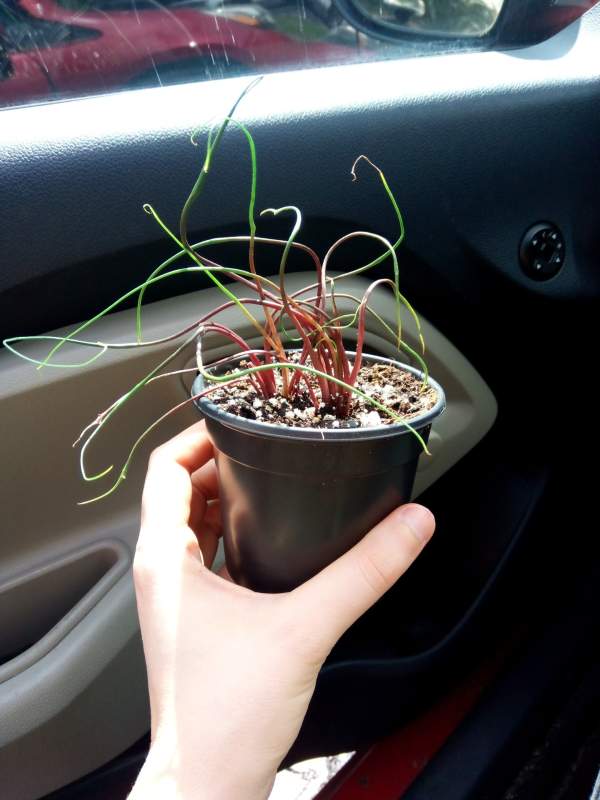
Alocasia Plumbae has spooky and unusual leaves, that are green and burgundy
Alocasia Plumbae Flying Squid Plant Care
Despite its unusual appearance, Alocasia Flying Squid care isn’t complex. Ensure that your plant gets plenty of bright indirect light (more than 3,000 lux), water it when the top half of the soil dries out, and provide well-draining soil, and it will thrive.
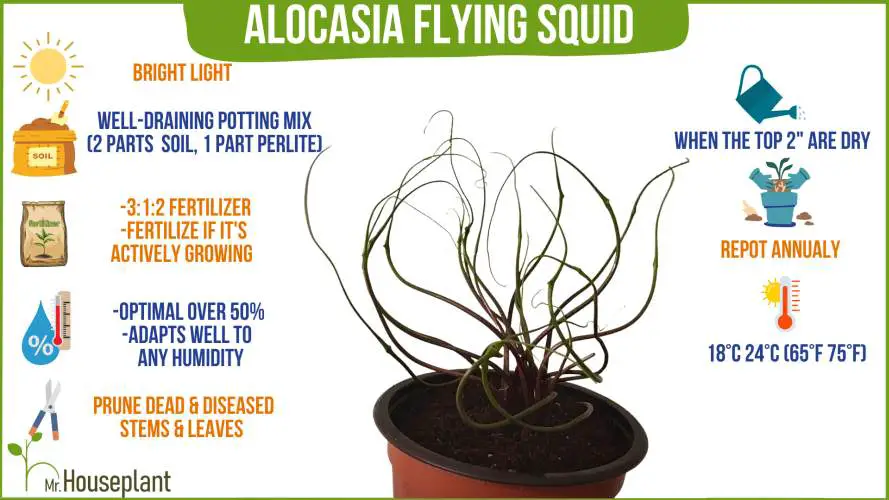
Make sure to follow these care requirements such as temperature, humidity levels, watering, light, soil, pruning and repotting. Photo by: _feffers_
Light Requirements
| Minimal amount of light: | 3,000 lux (300 FC) |
| Optimal amount of light: | 5,000 lux (500 FC) |
| Direct sun tolerance: | 1-2 hours |
| Category: | bright light |
Alocasia F. Squid Plant will grow best if you provide it with plenty of bright indirect light (more than 3,000 lux or 300 foot candles). More light boosts photosynthesis which enhances growth and makes the plant more resilient to different pathogens and pests. If you’re able to give your plant even more light, it will be even happier and healthier.

Open the blinds on your window to increase light 10x-50x. Photo of Alocasia Flying S. by: _feffers_
Just make sure not to overexpose your Alocasia to direct sun, as this could lead to leaf damage. Aim for a maximum of 1-2 hours of early morning or late afternoon direct sun.
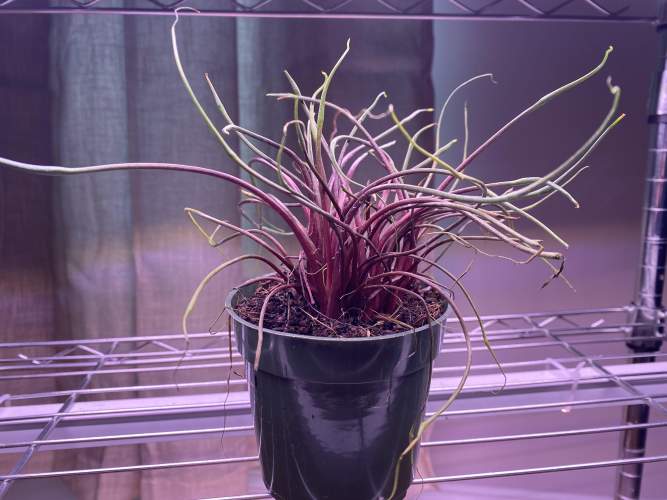
Alocasia Flying Squid mature plant will have lush foliage if you provide it with plenty of bright, indirect light
Water Needs
You should water your Alocasia when the top half of the soil dries out. The easiest way to check this is with a chopstick. Take a chopstick, push it into the soil all the way to the bottom of the container. Pull the chopstick out and if the upper half is completely clean without any soil sticking to it, it’s time to water your plant.
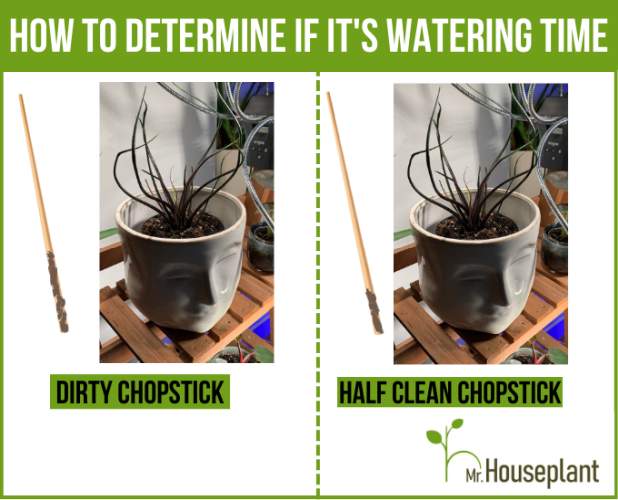
Check if it’s watering time with a chopstick: 1) left - if the whole part of the chopstick that was in the soil is dirty, wait more before watering 2) right - if the upper half of the part that was in soil is completely clean, without any soil sticking to it, it's time to water the plant
The watering frequency will depend on different factors in your home, such as temperature, humidity, airflow, etc. The chopstick method will ensure your plant gets watered at the optimal time.
Overwatering your plant can lead to root rot, that’s why it’s important to pick pots with drainage holes, so any excess water can flow out of the pot. You can also avoid overwatering by creating a porous, well-draining potting mix.
Humidity Needs
Alocasia F. Squid enjoys humidity levels of over 50%. The plant might be able to tolerate lower humidity, but since it’s still quite rare, I haven’t been able to confirm this information from reliable sources.
Temperature Requirements
Alocasia Plumbae Flying Squid will flourish in temperatures ranging from 65°F to 75°F (18°C to 24°C).
Fertilizing
You can fertilize your plant every 4 weeks with a high-nitrogen fertilizer when it’s actively growing. Although, if you repot your Alocasia plant once a year, it’s not obligatory to fertilize it, because new soil will give the plant everything it needs in terms of nutrients and minerals.
Avoid fertilizing the plant when it’s not actively growing. This will lead to nutrient accumulation in the soil since the plant won’t be able to utilize the nutrients. Eventually, this can cause root burn and be detrimental to the plant’s health.
Soil
To make the most suitable potting mix for your Flying Squid Alocasia, mix 2 parts of any commercial potting mix and 1 part perlite or some other coarse amendment.
The optimal soil for this plant is the one that is well-draining, and rich in oxygen. Potting mixes that can be found in stores are usually not well-draining. They retain too much moisture, and it takes more time for the soil to dry out, which increases the chances of root rot.
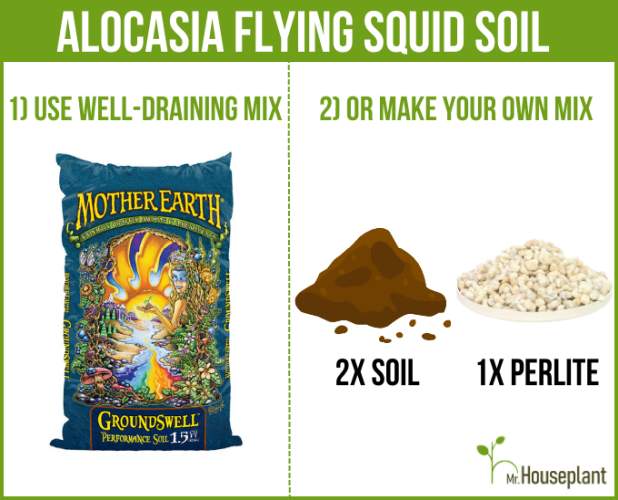
Mix 2x soil and 1x perlite to get your own potting mix or buy a well-draining one
Adding amendments with large particles, such as perlite or pumice, makes soil porous and loose and reduces soil compaction. Amendments with large particles create macro pores which contain oxygen. Oxygen is a vital element for healthy roots. If the roots are healthy, they can absorb water and nutrients efficiently, which improves the plant’s sturdiness.
Repotting
These are the steps to repot your Alocasia Squid Plant:
- Pick a pot that is one size larger than the current one
- Fill the new pot up to one-third with fresh, well-draining soil mix
- Take the plant from its pot and gently loosen the rootball
- If you notice any sick, dead, or mushy and smelly roots, cut them off
- Put your Alocasia in the middle of its new pot
- Fill up the pot with fresh soil mix
- Press the soil around the plant and water the plant
You should repot your plant once a year, or if it has overgrown its pot. You will know it’s time for repotting if you take the entire plant out of the pot and you can mostly see intertwined roots and not so much soil. Or you can look at the drainage holes, and if you spot some roots sticking out of the holes, it’s time to repot the plant.
Choose a pot with drainage holes since this plant doesn’t like to sit in waterlogged soil.
Toxicity To Humans
According to the California Poison Control System (CPCS) Alocasia Plumbae belongs to the Alocasia family, and plants from this genus are toxic to humans. They contain oxalate crystals that can cause irritation, pain, and swelling of the lips, mouth, and tongue if they are ingested. In more severe cases, oxalate crystals can provoke throat swelling and breathing issues as a consequence.
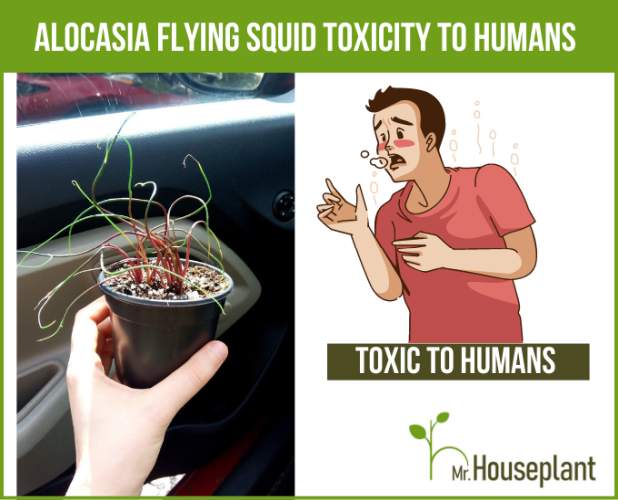
This plant contains oxalate crystals and can cause some irritations to humans
Toxicity To Pets
According to the American Society For Prevention Of Cruelty To Animals (ASPCA), the plants belonging to the Alocasia genus are toxic to cats and dogs. The insoluble calcium oxalates in these plants can cause irritation, pain, and swelling of the oral cavity, excessive drooling, vomiting, and difficulty swallowing. Keep your pets at a safe distance from your Alocasia plants.
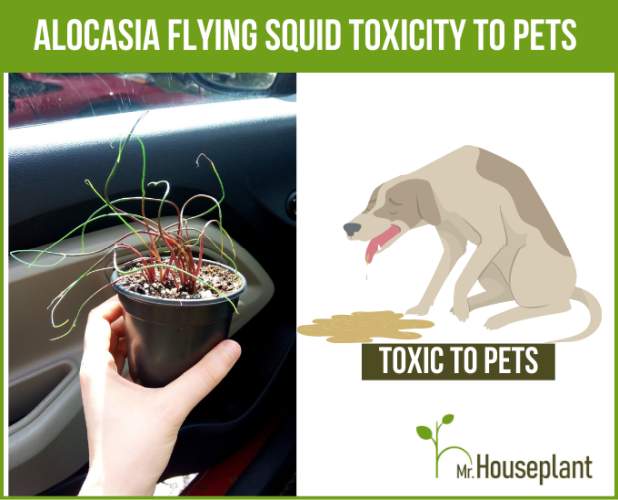
Make sure that your pets are away from this plant
Pruning
You should prune the plant if you notice any dead or disease-affected tissue.You don’t have to prune your Alocasia Squid Plant if it’s healthy.
Pest Prevention
Alocasia plants are generally robust, but they can be prone to spider mites. Prevention is vital since it’s easier to prevent an infestation than to cure the plant.
To decrease the chances of your Alocasia Squid plant becoming infested, you should strive to give it optimal conditions for growth. Ensure that all its basic care requirements, such as watering, light, and soil, are met.
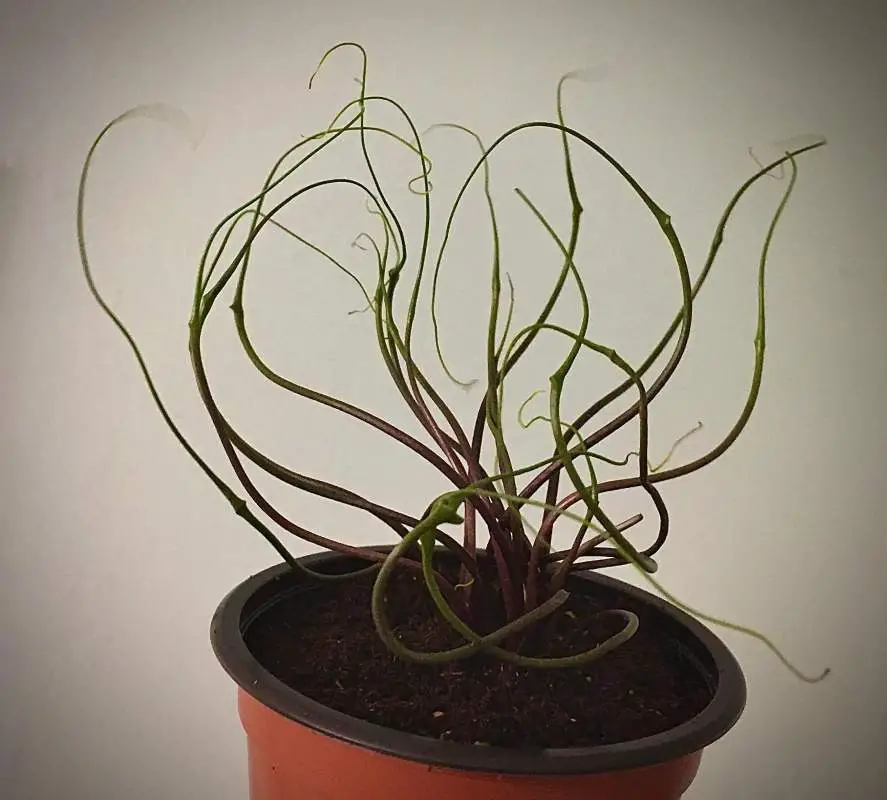
To prevent pests from infecting your Alocasia plant, make sure to provide good light, well-draining potting mix and proper watering. Photo by: _feffers_
Plants that are stressed or in bad shape tend to be more prone to pests. Always choose a healthy plant and inspect the soil for any signs of pests. After you bring your new plant home, treat it preventatively with insecticidal soap or horticultural oil, quarantine it, and keep it separate from your other plants for about 2 weeks, to prevent any possible contamination.
Common Problems
Leaves Turning Brown
Leaves can turn brown due to one of the following reasons: too much direct sunlight, insufficient light, inadequate watering, or compacted soil. If you expose your F.Squid to too much direct sunlight, its tiny leaves may become sunburned and turn brown. To avoid sunburns, make sure that you give your F.Squid no more than 1-2 hours of direct early morning or evening sunlight.
If you don’t provide sufficient light, leaves that the plant cannot support will dry out and turn brown.
Inadequate watering (too frequent or too infrequent) can lead to some of the leaves dying off and turning brown. To avoid this, water your Alocasia once the top half of the soil dries out and make sure to use a pot with drainage holes to avoid excessive moisture in the soil.
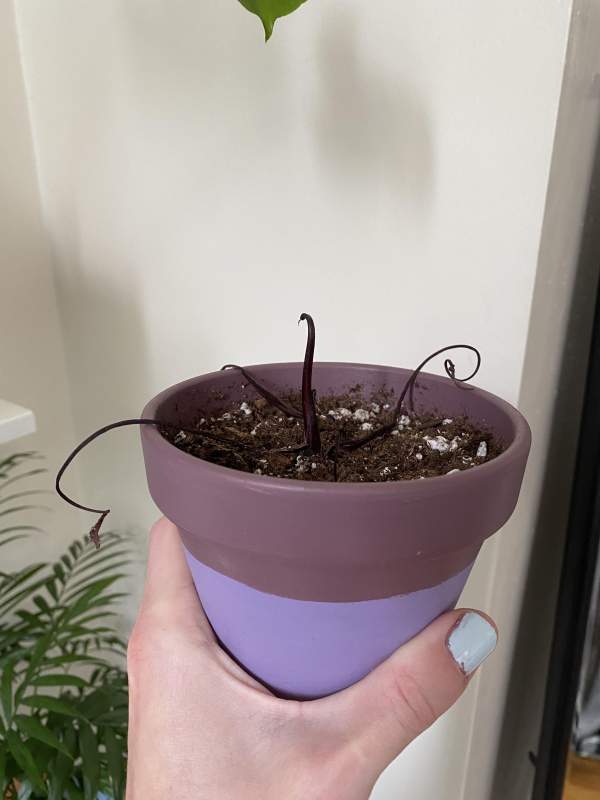
Insufficient light and inadequate watering
Stretchy Leaves
If your plant doesn’t get enough light, its leaves will become elongated and stretchy in an attempt to reach the source of light. To fix this issue, aim to give your F. Squid at least 3,000 lux or 300 foot candles of light. If you can’t provide your plant with enough natural light, you can use a grow light to meet its light requirements.
FAQs about Alocasia Flying Squid
What Is The Scientific Name For Alocasia Flying Squid?
The scientific name for Alocasia Flying Squid is Alocasia Plumbae.
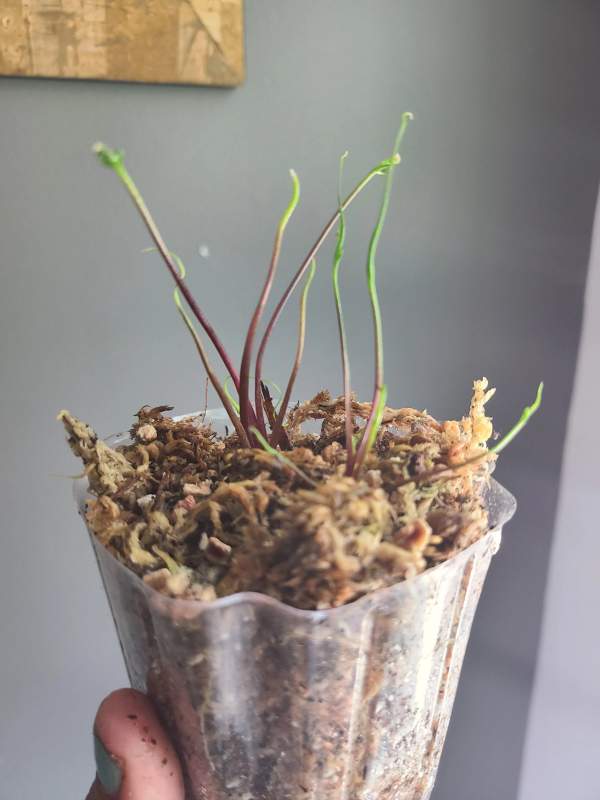
Young Alocasia Squid
Where Can I Buy Alocasia Flying Squid?
You can buy Alocasia Flying Squid on Etsy or Amazon.
Conclusion
If you’re a fan of rare plants that aren’t too fussy when it comes to care requirements, Alocasia Squid is a great choice for you. This fun plant with leaves that look like squid tentacles is versatile and adaptable to different aesthetics, and it will certainly be a unique addition to your plant collection.
Yours Truly,



Related Posts
Sansevieria Black Gold (Snake Plant Care GUIDE!)
Spathiphyllum Sensation (FULLY Explained!)
Alocasia Stingray Care